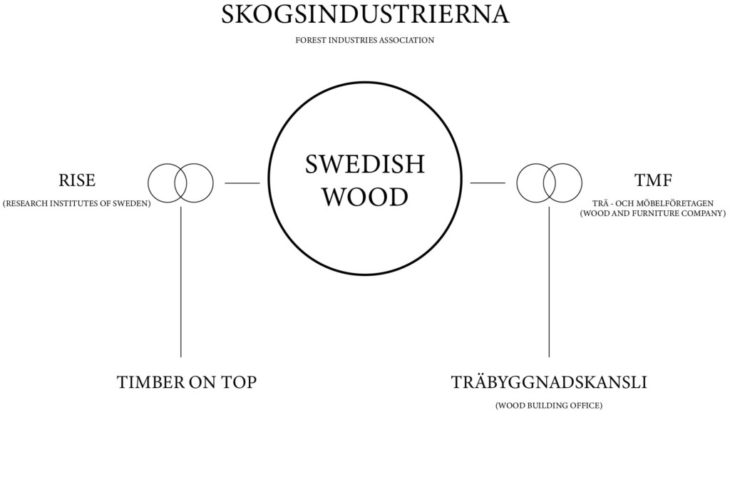
The following text is the result of my personal interest in the timber construction sector in Sweden and specifically in an organization called Swedish Wood, that has the mission to increase the use and the value of Swedish timber products all over the world.
Background
The forestry industry is one of the most important economic sectors in Sweden, where 70% of the country is covered by forests. That accounts for 28 million hectares, or 1% of the world’s forest share, in a country of 10 million inhabitants. The production of wood is growing year by year thanks to the forest management policy of planting two trees for every harvested tree, making it a sustainable exploitation of raw material. In fact, Sweden has twice as much forest as it did 100 years ago, and its growth also means that the harvest can be increased year by year, contributing further to the Swedish economy. Since the country does not consume all the wood, pulp and paper products it produces, the sector is mainly export-oriented, and Sweden is today the third exporter of wood-related products in the world, after Russia and Canada.

Swedish sawn softwood production. Source: Skogsindustrierna
The sector is represented by the Swedish Forest Industries association (Skogsindustrierna in Swedish) which includes timber wholesalers, sawmills, forest owners, paper producers, and other actors related with the sector. Under the umbrella of this broad association, we find Swedish Wood (Svenskt Trä), an organization that works for the promotion of Swedish wood and timber products, both nationally and internationally. With an independent financing from that of the Swedish Forest Industries, Swedish Wood has created a network of collaborations and initiatives that help to lift wood products and educate consumers for a good use of Swedish timber. Its influence and growth have grown in parallel to the general interest in timber products, specially in the construction sector.
Swedish Wood

Swedish Wood website interface. Accessed July 2022
Swedish Wood’s main mission is to increase the use and value of Swedish timber in Sweden and worldwide. They do it through education, research and development, inspiration, and international relationships. The association is financed by the country’s sawmills, that voluntarily decide to be a part of Swedish Wood and contribute to it economically. They pay depending on the volume of wood they harvest, with a total turnover of approximately 6 million euros per year. This money is then spent in the different areas mentioned above.
At a national level, Swedish Wood has witnessed an exponential growth in the use of wood products and in the development of timber construction. Although the organization covers a very specific time in the product’s value chain, from its manufacturing as a ready-to-use product until its commercialization, they do cover a wide range of products, from packaging to mass timber structural products, to façade coverings or wood furniture. The will to focus on mass timber construction as a solution for the challenges presented by climate change and a growing population led to the creation of two other organizations: Wood Building Office (Träbyggnadskansli) and Timber on Top.
Träbyggnadskansli is a product of the collaboration between Swedish Wood and Trä-och Möbelföretagen (Wood and Furniture Company), TMF. It focuses on promoting the use of timber as a structural material for new construction in the Swedish market. Their mission is to spread the word about the benefits of building with wood, not only for the climate, but also from an economic and time-saving perspective. They are very active in social media and in national seminars or conferences: anywhere where they can promote timber construction. They have their own website and have put together the platform Woodprint Sweden, that maps all projects built with timber in Sweden, both finished and upcoming

Relation between Swedish Wood, Träbyggnadskansli and Timber on Top
A model to export?
In recent years, the Swedish Forestry Industry has succeeded in developing a strong economic sector that continues to grow, although some voices discuss the Swedish way of managing the forest. In any case, Swedish Wood is contributing to strengthen the presence and quality of wood in many different sectors, nonetheless in the building industry. Its transversal and inclusive approach, from the sawmill to the consumer, and the many fronts they direct their actions to, can definitely be a source of inspiration for countries willing to develop wood construction and to transition into a circular bioeconomy.
For more information about the different organizations mentioned in this post, please visit:
https://www.swedishwood.com/
https://www.forestindustries.se/
https://woodprintsweden.se/
(in Swedish)
Spread the wood: Swedish Wood and the promotion of Swedish timber is a project of IAAC, Institute for Advanced Architecture of Catalonia developed for MMTD in 2022 by student Maria Cotela Dalmau. Faculty: Daniel Ibáñez. Course: Narratives